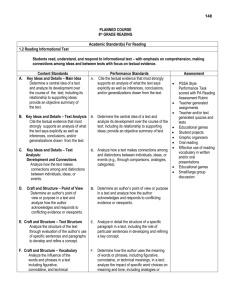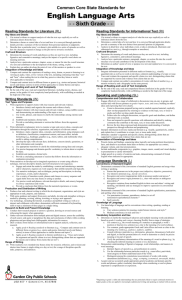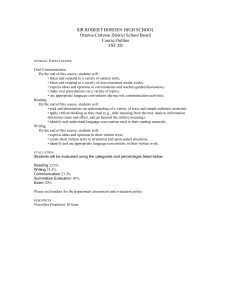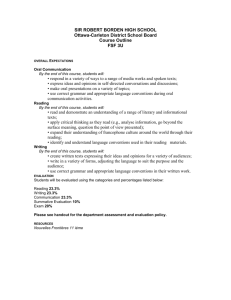6th Grade ELA Curriculum Map
advertisement
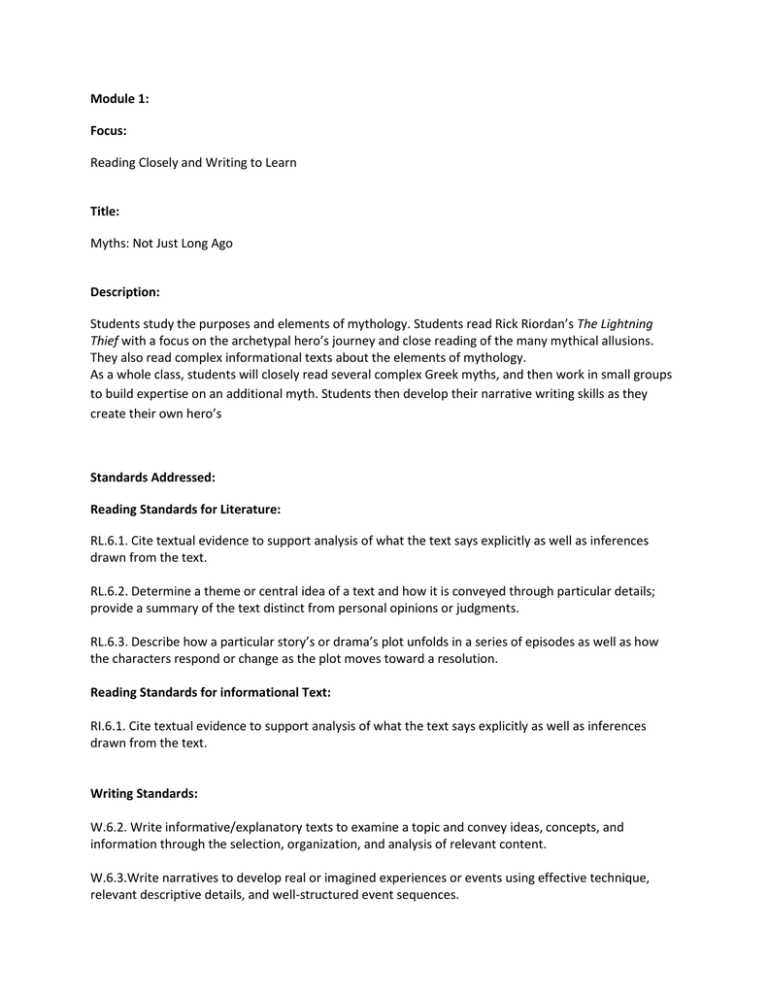
Module 1: Focus: Reading Closely and Writing to Learn Title: Myths: Not Just Long Ago Description: Students study the purposes and elements of mythology. Students read Rick Riordan’s The Lightning Thief with a focus on the archetypal hero’s journey and close reading of the many mythical allusions. They also read complex informational texts about the elements of mythology. As a whole class, students will closely read several complex Greek myths, and then work in small groups to build expertise on an additional myth. Students then develop their narrative writing skills as they create their own hero’s Standards Addressed: Reading Standards for Literature: RL.6.1. Cite textual evidence to support analysis of what the text says explicitly as well as inferences drawn from the text. RL.6.2. Determine a theme or central idea of a text and how it is conveyed through particular details; provide a summary of the text distinct from personal opinions or judgments. RL.6.3. Describe how a particular story’s or drama’s plot unfolds in a series of episodes as well as how the characters respond or change as the plot moves toward a resolution. Reading Standards for informational Text: RI.6.1. Cite textual evidence to support analysis of what the text says explicitly as well as inferences drawn from the text. Writing Standards: W.6.2. Write informative/explanatory texts to examine a topic and convey ideas, concepts, and information through the selection, organization, and analysis of relevant content. W.6.3.Write narratives to develop real or imagined experiences or events using effective technique, relevant descriptive details, and well-structured event sequences. W.6.4. Produce clear and coherent writing in which the development, organization, and style are appropriate to task, purpose, and audience. W.6.5. With some guidance and support from peers and adults, develop and strengthen writing as needed by planning, revising, editing, rewriting, or trying a new approach. W.6.9. Draw evidence from literary or informational texts to support analysis, reflection, and research. W.6.10.Write routinely over extended time frames (time for research, reflection, and revision) and shorter time frames (a single sitting or a day or two) for a range of discipline-specific tasks, purposes, and audiences. Language Standards: L.6.1. Demonstrate command of the conventions of standard English grammar and usage when writing or speaking. 6.2. Demonstrate command of the conventions of standard English capitalization, punctuation, and spelling when writing. L.6.3. Use knowledge of language and its conventions when writing, speaking, reading, or listening. L.6.6. Acquire and use accurately grade-appropriate general academic and domain-specific words and phrases; gather vocabulary knowledge when considering a word or phrase important to comprehension or expression. Module 2A: Focus: Working with Evidence Title: Rules to Live By Description: How do people formulate and use “rules” to improve their lives and communicate these “rules” to others? Students consider these questions as they read a variety of texts. They begin with Bud, not Buddy, analyzing character development and considering how figurative language contributes to tone and meaning. They then read closely Steve Jobs’ speech, (focusing on how Jobs develops his ideas at the paragraph, sentence, and word level) and analyze the poem “If” to compare and contrast how the novel and the poem address a similar theme. In an argument essay, students establish a claim about how Bud uses his rules. Finally, students conduct a short research project related to their own “rules to live by” and then write an essay to inform about one important “rule to live by.” Standards Addressed: Reading Standards for Literature: RL.6.1. Cite textual evidence to support analysis of what the text says explicitly as well as inferences drawn from the text. RL.6.2. Determine a theme or central idea of a text and how it is conveyed through particular details; provide a summary of the text distinct from personal opinions or judgments. RL.6.4. Determine the meaning of words and phrases as they are used in a text, including figurative and connotative meanings; analyze the impact of a specific word choice on meaning and tone. RL.6.5. Analyze how a particular sentence, chapter, scene, or stanza fits into the overall structure of a text and contributes to the development of the theme, setting, or plot. RL.6.6. Explain how an author develops the point of view of the narrator or speaker in a text. A. Explain how an author’s geographic location or culture affects his or her perspective. 3 RL.6.7. Compare and contrast the experience of reading a story, drama, or poem to listening to or viewing an audio, video, or live version of the text, including contrasting what they “see” and “hear” when reading the text to what they perceive when they listen or watch. RL.6.9. Compare and contrast texts in different forms or genres (e.g., stories and poems; historical novels and fantasy stories) in terms of their approaches to similar themes and topics. Reading Standards for informational Text: RI.6.1. Cite textual evidence to support analysis of what the text says explicitly as well as inferences drawn from the text. RI.6.2. Determine a central idea of a text and how it is conveyed through particular details; provide a summary of the text distinct from personal opinions or judgments. RI.6.4. Determine the meaning of words and phrases as they are used in a text, including figurative, connotative, and technical meanings. RI.6.5. Analyze how a particular sentence, paragraph, chapter, or section fits into the overall structure of a text and contributes to the development of the ideas. Writing Standards: W.6.1. Write arguments to support claims with clear reasons and relevant evidence. W.6.2. Write informative/explanatory texts to examine a topic and convey ideas, concepts, and information through the selection, organization, and analysis of relevant content. W.6.4. Produce clear and coherent writing in which the development, organization, and style are appropriate to task, purpose, and audience. W.6.5. With some guidance and support from peers and adults, develop and strengthen writing as needed by planning, revising, editing, rewriting, or trying a new approach. W.6.9. Draw evidence from literary or informational texts to support analysis, reflection, and research. Speaking and Listening Standards: SL.6.1. Engage effectively in a range of collaborative discussions (one-on-one, in groups, and teacherled) with diverse partners on grade 6 topics, texts, and issues, building on others’ ideas and expressing their own clearly. Language Standards: L.6.1. Demonstrate command of the conventions of standard English grammar and usage when writing or speaking. L.6.2. Demonstrate command of the conventions of standard English capitalization, punctuation, and spelling when writing. L.6.5. Demonstrate understanding of figurative language, word relationships, and nuances in word meanings. L.6.6. Acquire and use accurately grade-appropriate general academic and domain-specific words and phrases; gather vocabulary knowledge when considering a word or phrase important to comprehension or expression. Module 3A: Focus: Understanding Perspectives Title: The Land of the Golden Mountain Description: Students study how an author develops point of view and how an author’s perspective, based on his or her culture, is evident in the writing. As students read Lawrence Yep’s Dragonwings, they analyze how Yep has developed the point of view of the narrator, Moon Shadow. They also read excerpts of Yep’s biography The Lost Garden to determine how his culture and experiences have shaped his perspective as evidenced in the novel. They read accounts by people from the turn of the century in San Francisco, analyzing perspective and comparing the accounts to those in the novel. Finally, students write newspaper articles that convey multiple perspectives about life for Chinese immigrants in San Francisco in the early 1900s. Standards Addressed: Reading Standards for Literature: RL.6.4. Determine the meaning of words and phrases as they are used in a text, including figurative and connotative meanings; analyze the impact of a specific word choice on meaning and tone. RL.6.5. Analyze how a particular sentence, chapter, scene, or stanza fits into the overall structure of a text and contributes to the development of the theme, setting, or plot. RL.6.6. Explain how an author develops the point of view of the narrator or speaker in a text. A. Explain how an author’s geographic location or culture affects his or her perspective. 3 RL.6.11. Recognize, interpret, and make connections in narratives, poetry, and drama, ethically and artistically to other texts, ideas, cultural 4 perspectives, eras, personal events, and situations. A. Self-select text based on personal preferences. 5 Reading Standards for Informational Text: RI.6.3. Analyze in detail how a key individual, event, or idea is introduced, illustrated, and elaborated in a text (e.g., throu RI.6.4. Determine the meaning of words and phrases as they are used in a text, including figurative, connotative, and tech RI.6.6. Determine an author’s point of view or purpose in a text and explain how it is conveyed in the text. RI.6.7. Integrate information presented in different media or formats (e.g., visually, quantitatively) as well as in words to develop a coherent understanding of a topic or issue. Writing Standards: W.6.2. Write informative/explanatory texts to examine a topic and convey ideas, concepts, and information through the selection, organization, and analysis of relevant content. W.6.4. Produce clear and coherent writing in which the development, organization, and style are appropriate to task, purpose, and audience. W.6.5. With some guidance and support from peers and adults, develop and strengthen writing as needed by planning, revising, editing, rewriting, or trying a new approach. W.6.7. Conduct short research projects to answer a question, drawing on several sources and refocusing the inquiry when appropriate. W.6.9. Draw evidence from literary or informational texts to support analysis, reflection, and research. W.6.10.Write routinely over extended time frames (time for research, reflection, and revision) and shorter time frames (a single sitting or a day or two) for a range of discipline-specific tasks, purposes, and audiences. W.6.11. Create and present a text or artwork in response to a literary work. 7 Speaking and Listening Standards: SL.6.2. Interpret information presented in diverse media and formats (e.g., visually, quantitatively, orally) and explain how it contributes to a topic, text, or issue under study. Language Standards: L.6.2. Demonstrate command of the conventions of standard English capitalization, punctuation, and spelling when writing. L.6.3. Use knowledge of language and its conventions when writing, speaking, reading, or listening. L.6.4. Determine or clarify the meaning of unknown and multiple-meaning words and phrases based on grade 6 reading and content, choosing flexibly from a range of strategies. L.6.6. Acquire and use accurately grade-appropriate general academic and domain-specific words and phrases; gather vocabulary knowledge when considering a word or phrase important to comprehension or expression. Module 4: Title: Reading for Research and Writing an Argument Focus: Reading for Research and Writing an Argument Description: Students consider the balance between human needs and environmental consequences as they read the novel Frightful’s Mountain and complex informational texts about the benefits and drawbacks of the use of DDT. They learn how to trace and evaluate an argument in written texts and videos on this topic, and conduct both supported and independent research. Through structured discussions and decision-making protocols, students form their own argument about the use of DDT. Students then apply their research to write a position paper in which they support that claim with evidence. Standards Addressed: Reading Standards for Literature: RL.6.1. Cite textual evidence to support analysis of what the text says explicitly as well as inferences drawn from the text. RL.6.10. By the end of the year, read and comprehend literature, including stories, dramas, and poems, in the grades 6–8 text complexity band proficiently, with scaffolding as needed at the high end of the range. Integrated throughout. RL.6.11. Recognize, interpret, and make connections in narratives, poetry, and drama, ethically and artistically to other texts, ideas, cultural perspectives, eras, personal events, and situations. Integrated throughout. 4 Reading Standards for Informational Text: RI.6.8. Trace and evaluate the argument and specific claims in a text, distinguishing claims that are supported by reasons and evidence from claims that are not. RI.6.9. Compare and contrast one author’s presentation of events with that of another (e.g., a memoir written by and a biography on the same person). A. Use their experience and their knowledge of language and logic, as well as culture, to think analytically, address problems creatively, and advocate persuasively. Writing Standards: W.6.1. Write arguments to support claims with clear reasons and relevant evidence. W.6.4. Produce clear and coherent writing in which the development, organization, and style are appropriate to task, purpose, and audience. W.6.5. With some guidance and support from peers and adults, develop and strengthen writing as needed by planning, revising, editing, rewriting, or trying a new approach. W.6.6. Use technology, including the Internet, to produce and publish writing as well as to interact and collaborate with others; demonstrate sufficient command of keyboarding skills to type a minimum of three pages in a single sitting. W.6.7. Conduct short research projects to answer a question, drawing on several sources and refocusing the inquiry when appropriate. W.6.8. Gather relevant information from multiple print and digital sources; assess the credibility of each source; and quote or paraphrase the data and conclusions of others while avoiding plagiarism and providing basic bibliographic information for sources. W.6.10.Write routinely over extended time frames (time for research, reflection, and revision) and shorter time frames (a single sitting or a day or two) for a range of discipline-specific tasks, purposes, and audiences. Speaking and Listening Standards: SL.6.2. Interpret information presented in diverse media and formats (e.g., visually, quantitatively, orally) and explain how it contributes to a topic, text, or issue under study. SL.6.3. Delineate a speaker’s argument and specific claims, distinguishing claims that are supported by reasons and evidence from claims that are not. SL.6.4. Present claims and findings, sequencing ideas logically and using pertinent descriptions, facts, and details to accentuate main ideas or themes; use appropriate eye contact, adequate volume, and clear pronunciation. SL.6.5. Include multimedia components (e.g., graphics, images, music, sound) and visual displays in presentations to clarify information. SL.6.6. Adapt speech to a variety of contexts and tasks, demonstrating command of formal English when indicated or appropriate. Language Standards: L.6.1. Demonstrate command of the conventions of standard English grammar and usage when writing or speaking. L.6.4. Determine or clarify the meaning of unknown and multiple-meaning words and phrases based on grade 6 reading and content, choosing flexibly from a range of strategies. L.6.6. Acquire and use accurately grade-appropriate general academic and domain-specific words and phrases; gather vocabulary knowledge when considering a word or phrase important to comprehension or expression.


